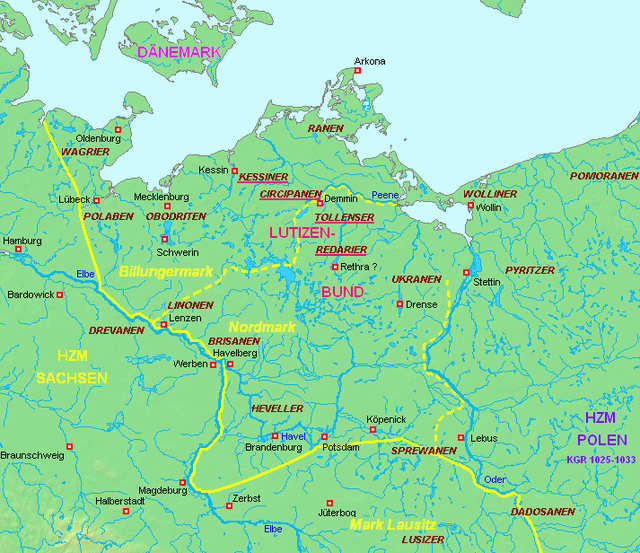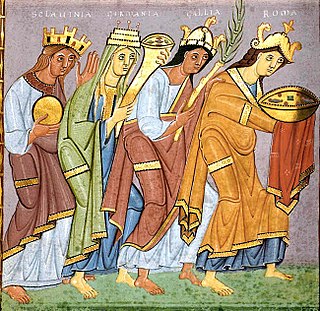Background
The Slavic peoples between the Elbe and the Baltic coast had been conquered and nominally converted to Christianity by the campaigns of the German king Henry the Fowler and his son Otto I, who in 962 was crowned Holy Roman Emperor. Otto had most recently defeated an alliance of Obotrite and Circipani tribes at the 955 Battle on the Raxa. The conquered area east of the German Duchy of Saxony was initially organized within the vast Saxon Eastern March under Margrave Gero, but divided into smaller marches upon his death in 965.

The Baltic Sea is a mediterranean sea of the Atlantic Ocean, enclosed by Denmark, Estonia, Finland, Latvia, Lithuania, Sweden, northeast Germany, Poland, Russia and the North and Central European Plain.

Henry Ι the Fowler was the duke of Saxony from 912 and the elected king of East Francia from 919 until his death in 936. As the first non-Frankish king of East Francia, he established the Ottonian dynasty of kings and emperors, and he is generally considered to be the founder of the medieval German state, known until then as East Francia. An avid hunter, he obtained the epithet "the Fowler" because he was allegedly fixing his birding nets when messengers arrived to inform him that he was to be king.

Otto I, traditionally known as Otto the Great, was German king from 936 and Holy Roman Emperor from 962 until his death in 973. He was the oldest son of Henry I the Fowler and Matilda.
In order to stabilize his rule, Otto promoted the conversion of the Slavic population, establishing the bishoprics of Havelberg and Brandenburg in 948, followed by the Archbishopric of Magdeburg in 968, which in particular carried out active missionary work.

The Bishopric of Havelberg was a Roman Catholic diocese founded by King Otto I of Germany in 946, from 968 a suffragan to the Archbishops of Magedeburg. A Prince-bishopric (Hochstift) from 1151, Havelberg as a result of the Protestant Reformation was secularised and finally annexed by the margraves of Brandenburg in 1598.

The Archbishopric of Magdeburg was a Roman Catholic archdiocese (969–1552) and Prince-Archbishopric (1180–1680) of the Holy Roman Empire centered on the city of Magdeburg on the Elbe River.
Uprising
In 981 Archbishop Adalbert of Magdeburg, the "Apostle of the Slavs", died and his successor Gisilher had to struggle with the resistance by the Magdeburg chapter. He was backed by Emperor Otto II, who, however, was on campaign in Italy, where he suffered a disastrous defeat against the Sicilian Kalbids in the 982 Battle of Stilo and died the next year without having returned to Germany, leaving his minor son Otto III under the tutelage of the Empress consorts Theophanu and Adelaide of Burgundy.
Gisilher, Gisiler, Giseler, or Giselmar was the second Archbishop of Magdeburg, succeeding Saint Adalbert, from 981 until his death in 1004.

Otto II, called the Red (Rufus), was Holy Roman Emperor from 973 until his death in 983. A member of the Ottonian dynasty, Otto II was the youngest and sole surviving son of Otto the Great and Adelaide of Italy.

The Kingdom of Italy, also commonly Imperial Italy or Kingdom of Lombardy, was one of the constituent kingdoms of the Holy Roman Empire, along with the kingdoms of Germany, Bohemia, and Burgundy. It comprised northern and central Italy, but excluded the Republic of Venice and the Papal States. Its original capital was Pavia until the 11th century.
While there was internal dissention in the Holy Roman Empire, Slavic forces led by the Lutici revolted and drove out the political and religious representatives of the Empire. Starting from the Slavic sanctuary at Rethra, the bishops' seat of Havelberg on 29 June 983 was occupied and plundered, followed by Brandenburg three days later and numerous settlements up to the Tanger River in the west. According to the contemporary chronicler Thietmar of Merseburg, the Obotrites joined the Lutici, devastated a St Lawrence monastery in Kalbe, the bishopric of Oldenburg and even assaulted Hamburg.
Rethra was, in the 10th to the 12th centuries, the main town and political center of the Slavic Redarians, one of the four major Lutician tribes, located most likely in present-day Mecklenburg. It was also a major worship center, devoted to the cult of the Slavic deity Radegast-Swarożyc.
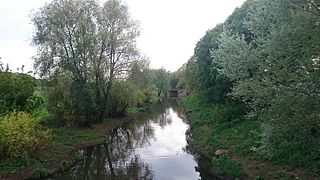
The Tanger is a small river of Saxony-Anhalt, Germany. It is a left tributary to the river Elbe at Tangermünde.
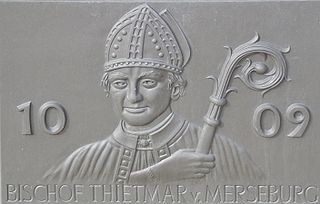
Thietmar, Prince-Bishop of Merseburg from 1009 until his death, was an important chronicler recording the reigns of German kings and Holy Roman Emperors of the Ottonian (Saxon) dynasty. Two of Thietmar's great-grandfathers, both referred to Liuthar, were the Saxon nobles Lothar II, Count of Stade, and Lothar I, Count of Walbeck. They were both killed fighting the Slavs at the Battle of Lenzen.
A hastily assembled Saxon army was only able to retain the Slavs behind the Elbe. The Northern March and the March of the Billungs were lost. The March of Lusatia as well as the adjacent marches of Zeitz, Merseburg and the Meissen in the south did not take part in the uprising.

The Northern March or North March was created out of the division of the vast Marca Geronis in 965. It initially comprised the northern third of the Marca and was part of the territorial organisation of areas conquered from the Wends. A Lutician rebellion in 983 reversed German control over the region until the establishment of the March of Brandenburg by Albert the Bear in the 12th century.

The Billung March or March of the Billungs was a frontier region of the far northeastern Duchy of Saxony in the 10th century. It was named after the family which held it, the House of Billung.

The March or Margraviate of Lusatia was as an eastern border march of the Holy Roman Empire in the lands settled by Polabian Slavs. It arose in 965 in the course of the partition of the vast Marca Geronis. Ruled by several Saxon margravial dynasties, among them the House of Wettin, the lordship was contested by the Polish kings as well as by the Ascanian margraves of Brandenburg. The remaining territory was finally incorporated into the Lands of the Bohemian Crown in 1367.
Aftermath
From 985, several Princes of the Empire carried out annual campaigns together with the Christian Polish princes Mieszko I and Bolesław I Chrobry to subjugate the area, however these campaigns were unsuccessful. In 1003 King Henry II of Germany tried a different approach: he allied himself with the Lutici and waged war against his previous ally Prince Bolesław of Poland. This stabilized the independence of the Lutici and ensured that the area remained ruled by Polabian Slavs and unchristianized into the 12th century.
The immediate consequences of the uprising were an almost complete stop on further German eastward expansion (Ostsiedlung) for the next 200 years. For most of the time, the dioceses of Brandenburg and Havelberg existed in titular form only, with the bishops residing at the royal court. Only in the 12th century after the Wendish Crusade of 1147 and the establishment of the Margraviate of Brandenburg under the Ascanian prince Albert the Bear in 1157, the settlements east of the Elbe were resumed; followed by the northern lands of Mecklenburg, where after several years of fighting against the Obotrite prince Niklot, his son Pribislav in 1167 declared himself a vassal of the Saxon Duke Henry the Lion.

The Prince-Bishopric of Brandenburg was an ecclesiastical principality of the Holy Roman Empire from the 12th century until it was secularized during the second half of the 16th century. It should not be confused with the larger Diocese of Brandenburg established by King Otto I of Germany in 948, in the territory of the Marca Geronis east of the Elbe river. The diocese, over which the prince-bishop exercised only spiritual authority, was a suffragan diocese of the Archdiocese of Magdeburg, its seat was Brandenburg an der Havel.

Year 983 (CMLXXXIII) was a common year starting on Monday of the Julian calendar.
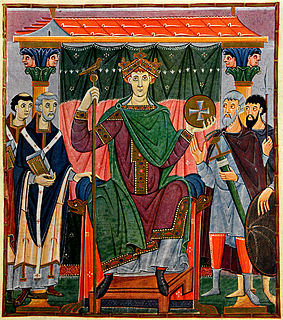
Otto III was Holy Roman Emperor from 996 until his early death in 1002. A member of the Ottonian dynasty, Otto III was the only son of the Emperor Otto II and his wife Theophanu.
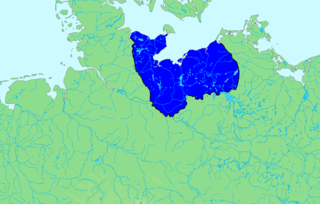
The Obotrites or Obodrites, also spelled Abodrites, were a confederation of medieval West Slavic tribes within the territory of modern Mecklenburg and Holstein in northern Germany. For decades, they were allies of Charlemagne in his wars against the Germanic Saxons and the Slavic Veleti. The Obotrites under Prince Thrasco defeated the Saxons in the Battle of Bornhöved (798). The still heathen Saxons were dispersed by the emperor, and the part of their former land in Holstein north of Elbe was awarded to the Obotrites in 804, as a reward for their victory. This however was soon reverted through an invasion of the Danes. The Obotrite regnal style was abolished in 1167, when Pribislav was restored to power by Duke Henry the Lion, as Prince of Mecklenburg, thereby founding the German House of Mecklenburg.

The Altmark is a historic region in Germany, comprising the northern third of Saxony-Anhalt. As the initial territory of the March of Brandenburg, it is sometimes referred to as the "Cradle of Prussia", as by Otto von Bismarck, a native from Schönhausen near Stendal.

The Wendish Crusade was a military campaign in 1147, one of the Northern Crusades and a part of the Second Crusade, led primarily by the Kingdom of Germany within the Holy Roman Empire and directed against the Polabian Slavs. The Wends are made up of the Slavic tribes of Abrotrites, Rani, Liutizians, Wagarians, and Pomeranians who lived east of the River Elbe in present-day northeast Germany and Poland.

The Diocese of Magdeburg is a diocese of the Latin Rite of the Roman Catholic church, located in the German state of Saxony-Anhalt. Its seat is Magdeburg; it is suffragan to the Archdiocese of Paderborn.

The Margravate of Meissen was a medieval principality in the area of the modern German state of Saxony. It originally was a frontier march of the Holy Roman Empire, created out of the vast Marca Geronis in 965. Under the rule of the Wettin dynasty, the margravate finally merged with the former Duchy of Saxe-Wittenberg into the Saxon Electorate by 1423.
Rikdag, also called Ricdag, Riddag, or Rihdag, was Margrave of Meissen from 979 until his death. In 982, he also acquired the marches of Merseburg and Zeitz. After the Great Slav Rising in 983, he temporarily reunited all of the southern marca Geronis under his command. His march included the territory of the Chutizi and Dolomici tribes.

The Saxon Eastern March was a march of the Holy Roman Empire from the 10th until the 12th century. The term "eastern march" stems from the Latin term marchia Orientalis and originally could refer to either a march created on the eastern frontier of the East Frankish duchy of Saxony or another on the eastern border of the Duchy of Bavaria: the Bavarian marchia Orientalis, corresponding to later Austria.
Dietrichof Haldensleben was a Saxon count in the Schwabengau, later also in the Nordthüringgau and the Derlingau, who was the first Margrave of the Northern March from 965 until the Great Slav Rising of 983. He also bore the title of a dux (duke) in contemporary sources.
Lothair I was Margrave of the Nordmark from about 983 until his death. He was also a member of Saxon nobility as Count of Derlingau and of Nordthüringgau.
The Nakonids were the leading noble family of the Slavic peoples of the Elbe River from ca. 960 until 1129. They were themselves of Obotrite origin and engineered the formation of a Slavic principality in the region. They became extinct in the male line in the early 12th century. Their capital was Mecklenburg Castle.
The German–Polish War which took place from 1002 to 1018 consisted of a series of struggles between the Ottonian king Henry II of Germany and the Polish Piast ruler Bolesław I the Brave. The locus of conflict was the control of Lusatia, Upper Lusatia, as well as Bohemia, Moravia and Slovakia. The fighting ended with the Peace of Bautzen in 1018, which left Lusatia and Upper Lusatia as a fief to Poland, and Bohemia became a duchy in the Holy Roman Empire.
This page is based on this
Wikipedia article Text is available under the
CC BY-SA 4.0 license; additional terms may apply.
Images, videos and audio are available under their respective licenses.
